NCERT Class 8 Social Science Chapter 28 Human Resources Solutions to each chapter is provided in the list so that you can easily browse through different chapters NCERT Class 8 Social Science Chapter 28 Human Resources and select need one. NCERT Class 8 Social Science Chapter 28 Human Resources and After Question Answers Download PDF. NCERT SST Class 8 Solutions.
NCERT Class 8 Social Science Chapter 28 Human Resources
Also, you can read the NCERT book online in these sections Solutions by Expert Teachers as per Central Board of Secondary Education (CBSE) Book guidelines. CBSE Class 8 Social Science Solutions are part of All Subject Solutions. Here we have given NCERT Class 8 Social Science Chapter 28 Human Resources and After, NCERT Class 8 Social Science Textbook of Our Pasts – III: History, Social and Political Life – III: Civics, Resources, and Development: Geography. for All Chapters, You can practice these here.
Human Resources
Chapter: 28
RESOURCES AND DEVELOPMENT [GEOGRAPHY]
ACTIVITY
I. Look at the fig. 6.1 and find out continents which has population:
(a) Only 5 per cent.
(b) Only 13 per cent.
(c) Only 1 per cent.
(d) Only 12 per cent.
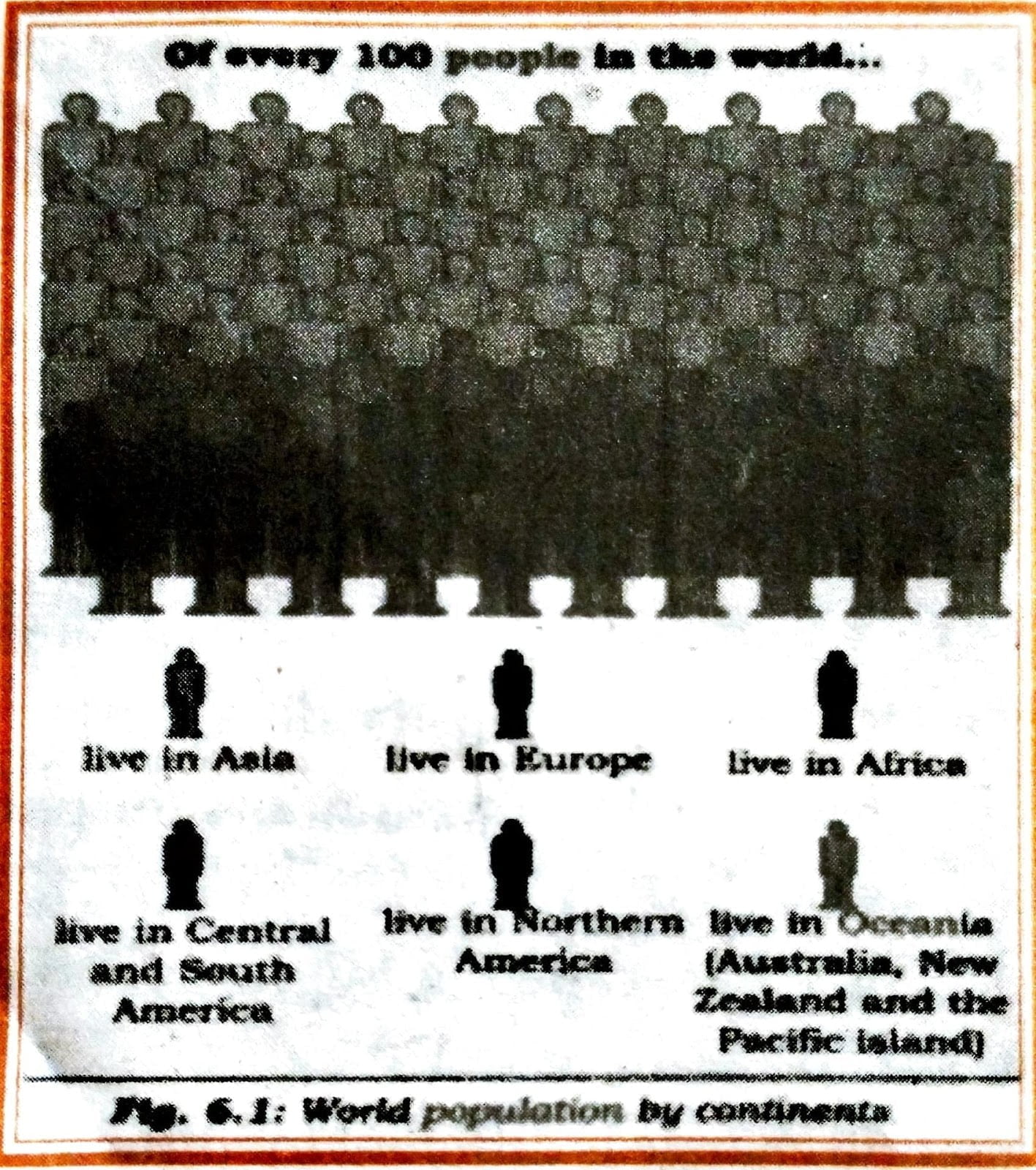
Ans. (a) North America.
(b) Africa.
(c) Oceania (Australia).
(d) Europe.
2. Look at the fig. 6.2. below and find out of these countries how many are in Asia. Colour them on map.
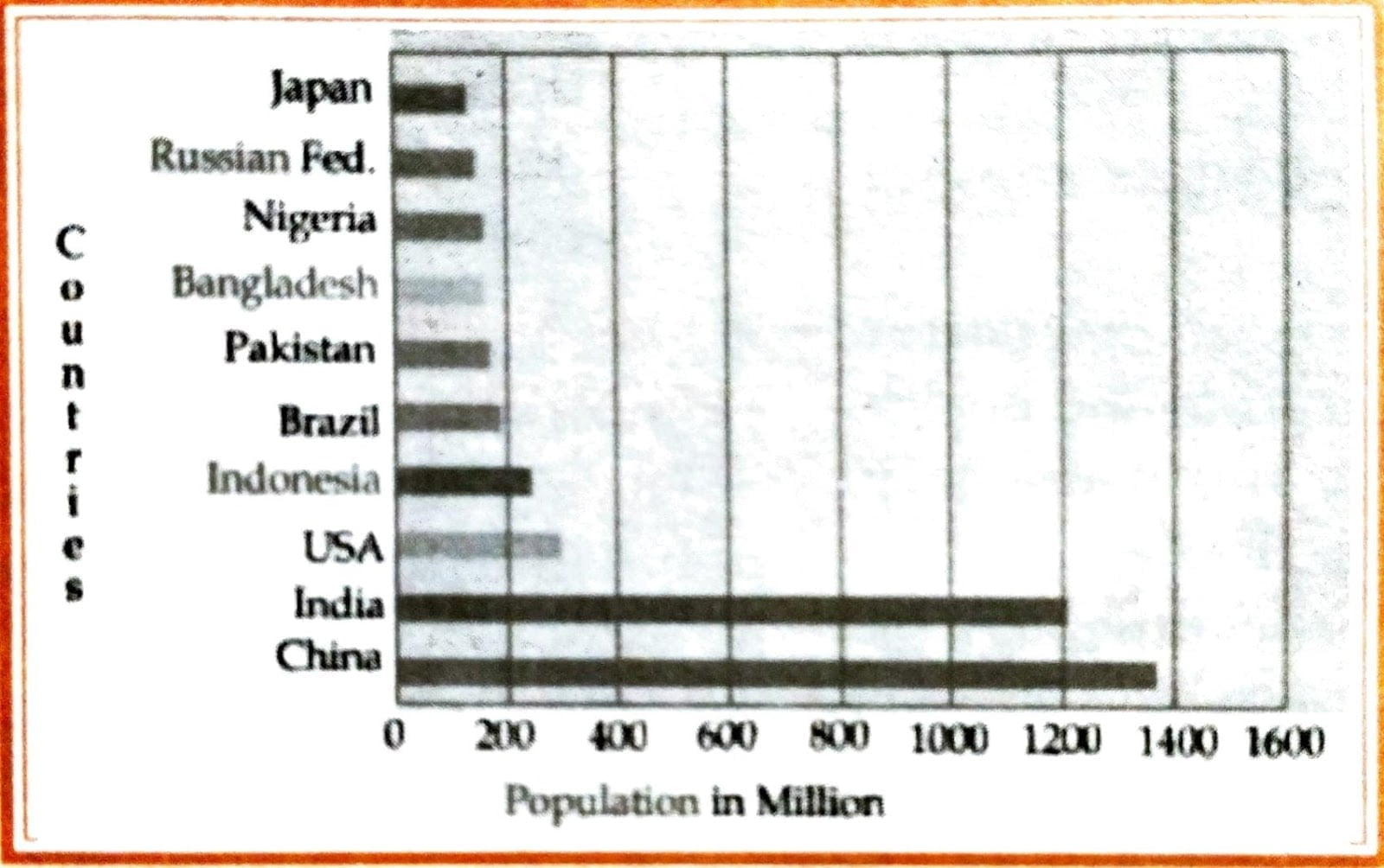
Ans. The countries in Asia are: China, India, Indonesia, Pakistan, Bangladesh, and Japan.
EXERCISES
Q.1. Answer the following questions
(i) What are people considered a resource?
Ans. People are considered a resource because it is the people who work on the natural resources, produce wealth and raise standard of living.
(ii) What are the causes for the uneven distribution of population in the world?
Ans. Causes for the uneven distribution of population are:
(a) Geographical factors:
(i) Topography: people always prefer to live on plains rather than mountains and plateau because these areas are suitable for farming, manufacturing and service activities. The Gang plains are the most densely populated areas of the world while mountains like Andes, Alps and Himalayas are sparsely populated.
(ii) Climate: People usually avoid extreme climates that are very hot or very cold like Sahara desert, Polar regions of Russia, Canada and Antarctica.
(iii) Soil: Fertile soils provide suitable land for agriculture. Fertile plains such as Ganga and Brahmaputra in India, Hwang-Ho, Chang Jiang in China and the Nile in Egypt are densely populated.
(iv) Water: People prefer to live in the areas where fresh water is easily available. The river valleys of the world are densely populated while deserts have sparse population.
(v) Minerals: Area with mineral deposits are more populated. Diamond mines of South Africa and discovery of oil in the Middle East lead to setting of people in these areas.
(b) Socio-cultural and economic factors:
(i) Social: Areas of the better housing, education and health facilities are more densely populated e.g., Pune.
(ii) Cultural: Places with religious or cultural significance attract people. Varanasi, Jerusalem and Vatican City are some examples.
(iii) Economic: Industrial areas provide employment opportunities.Large number of people are attracted to these areas. Osaka in Japan and Mumbai in India are two densely populated areas.
(iii) The world population is growing very rapidly. Why?
Ans. It is because of following reasons:
(a) Decrease in death rate due to increase food supplies and better medical facilities.
(b) Birth rate still very high.
(iv) Discuss the role of any two factors influencing the population change.
Ans. Population change refers to change in the number of people living during a specified period of time.
Main factors influencing population change are:
(a) The difference between the birth rate and death rate (natural growth rate) is the main cause of population change.
(b) Migration also bring about population change. Migration refers to the movement of people in and out of an area. People may move within a country or between countries.
(v) What is meant by population composition?
Ans. The different characteristics of population in terms of age, sex, literacy level, health condition, occupation and income level together form the composition of the population.
(vi) What are population pyramids? How do they help in understanding about the population of a country?
Ans. The distribution of various age groups in the population is shown by the age structure and male-female ratio diagram. This is called population pyramid.
The shape of the population pyramid of a country reveals two major details about the people’s age-group and sex ratio. It also tells us how many dependents are there in a country.
Q.2. Tick the correct answer
(i) Which does the term population distribution refers to?
(a) How population is specified area changes over time.
(b) The number of people who die in relation to the number of people born in a specified area.
(c) The way in which people are spread across given area.
Ans. (c) The way in which people are spread across given area.
(ii) Which are the three main factors that cause population change?
(a) Births, deaths and marriage.
(b) Births, deaths and migration.
(c) Births, deaths and life expectancy.
Ans. (b) Births, deaths and migration.
(iii) In 1999, the world population reached
(a) 1 billion.
(b) 3 billion.
(c) 6 billion.
Ans. (c) 6 billion.
(iv) What is a population pyramid?
(a) A graphical presentation of the age, sex composition of a population.
(b) When the population density of an area is so high that people live in tall buildings.
(c) Pattern of population distribution in large urban areas.
Ans. (c) Pattern of population distribution in large urban areas.
Q.3. Complete the sentences below using some of the following words:
sparsely, favourable, fallow, artificial, fertile, natural, extreme, densely
When people are attracted to an area it becomes ___________ populated. Factors that influence this include ____________ climate, good supplies of _____________ resources and ___________ land.
Ans densely, favourable, natural, fertile.
4. ACTIVITY
Q.4. Discuss the characteristics of a society with “too many under 15s” and one with “too few under 15’s”,
Hint: need for schools, pension schemes, teachers, toys, wheel chairs, labour supply, hospitals.
Ans. People of different age groups have different requirements. If a society has too many under 15s; it will require more teachers, toys, schools as per the needs of children. Labour supply will be less.
If a society has too few under 15s, it implies it has more adult population which will require more pension schemes, hospitals, wheel chairs. Labour supply will be more.
SOME OTHER IMPORTANT QUESTIONS FOR EXAMINATION
VERY SHORT TYPE QUESTIONS ANSWER
Q.1. Name two natural causes of population change.
Ans. Births and deaths.
Q.2. Distinguish between Emigrants and Immigrants.
Ans. Emigrants are those people who leave a country. Immigrants are those people who arrive in a country.
Q.3. In what respects does distribution of human resources differ in different areas of the world?
Ans. Human resources differ in their educational levels, age and sex. There number and characteristics also keep changing.
Q.4. How is population density normally expressed?
Ans, Population density is normally expressed as per square km.
Q,5. Name, three crowded areas of the world.
Ans. South and Southeast Asia, Europe and Northeastern North America.
Q.6. What is known as population explosion?
Ans. The very rapid increase in population is known as population explosion. For example in 1820, the world’s population was one billion and in the early 1970s, it reached 3 billions.
Q.7. What do you mean by life expectancy?
Ans. The number of years an average person can expect to live based on data, is known as life expectancy
Q.8. What do you mean by migration?
Ans. The movement of people from one place to another is called migration.
Q.9. Define population.
Ans. Population is said to be the number of people living in a particular region.
SHORT TYPE QUESTIONS ANSWER
Q.1. What are the factors which affect the literacy rate?
Ans. The factors which affect the literacy rate are as under:
(a) The level of economic development.
(b) Standard of living.
(c) Availability of educational facilities.
(d) Social status of women.
(e) Government policies.
Q.2. Why do people migrate?
Ans. People migrate because of the following reasons.
(a) People migrate from undeveloped to developed areas in search of better economic opportunities.
(b) People migrate to cities from rural areas to escape from unemployment, poverty, poor education and health facilities.
Q 3. Distinguish between population growth and natural increase.
Ans.
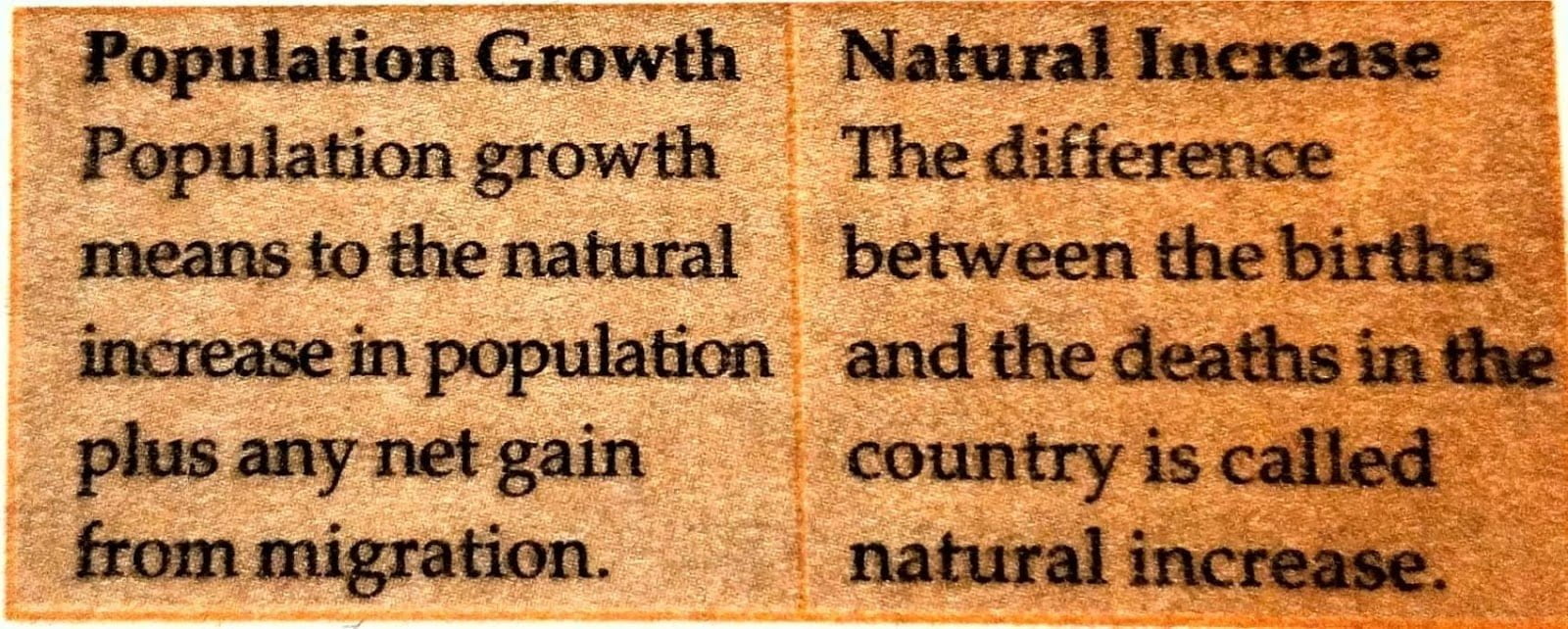
Q.4. Describe the factors affecting the population change in a region.
Ans. Factors affecting the population change in a region are:
(a) Birth rate: Birth rate is the number of live per 1000 people.
(b) Death rate: It measures the number of death per 1000 people.
(c) Migration: It refers the movements of people in and out of an area. People who leave a country are called emigrants and the people those who arrive in a country are called immigrants.
Q.5. Compare the population pyramids of India and Japan.
Ans.
| Population Pyramid of India | Population Pyramid of Japan |
| 1. Broad base of the pyramid indicates high birth rate. | 1. Narrow base of the pyramid indicates low birth rate. |
| 2. Infant mortality is less due to improved medical facilities. | 2. Low death rate indicates old age population is more and lives a longer life. |
| 3. Birth rate is more than death rate of children. | 3. Low birth rate means number of children growing into adults will be less. |
| 4. High birth rate means number of children growing into adults will be more. | 4. Overall population is less. |
| 5. Overall population is more. | 5. Narrow base of the pyramid indicates low birth rate. |
Q.6. Why is sex-ratio unfavourable in underdeveloped countries?
Ans. The sex-ratio is unfavourable underdeveloped countries because:
(a) Male births exceed female births in almost all societies due to biological reasons.
(b) Infant female mortality is higher. Female infants are killed just after birth and before birth as well. This is known as female foeticide.
(c) Life expectancy is lower in case of females because of less preferential treatment to most females in such countries.
Q. 7. Explain different patterns of population change.
Ans. Different patterns of population change can be explained as follows:
(a) Some countries like Kenya have high population growth. Now, with improving healthcare, death rates have fallen but birth rates still remain high leading to high growth rates.
(b) In other countries like United Kingdom, population growth is slowing because of both low death and low birth rates.
LONG TYPE QUESTIONS ANSWER
Q.1. Explain one reason for high or low density in the following areas:
(a) High Density: Eastern China, Indo Gangetic plains, Singapore, Bengaluru Coimbatore industrial region.
(b) Low Density: The Sahara, the Himalayas, Afghanistan, Amazon rain forests.
Ans. (a) High Density:
(i) Eastern China: Area with equitable and moderate climate.
(ii) Indo-Gangetic plains: Fertile plains also suitable for manufacturing and service activities.
(iii) Singapore: It is a country with stable government.
(iv) Bengaluru-Coimbatore Industrial region: Places with industries that provide employment opportunities and places with good infrastructural facilities.
(b) Low Density:
(i) The Sahara: Extremely hot climate.
(ii) The Himalayas: Mountain with steep slopes.
(iii) Afghanistan: Country with unstable government and engages in frequent wars.
(iv) Amazon Rainforests: Lack of infrastructural facilities.
Q.2. Discuss the different components of population composition.
Ans. The population composition refers to the structure of the population.
The different components of the population composition are:
(a) Age Composition: Age composition refers to the number of people in each age group. For example, the number of people in the age of 0-4 years, 5-9 years and so on.
(b) Sex Ratio: The ratio between males and females is known as sex ratio. It is represented as number of females per 1000 males.
(c) Dependency Ratio: The people below 15 years of age and above 65 years of age are taken as dependents of the economically active populations that falls between 15 and 64 years of age. Dependency ratio is calculated as the ratio between these two groups of population.
(d) Life Expectancy: This is defined as the average number of years to be lived by a group of people born in the same year.
HIGHER ORDER THINKING SKILL QUESTIONS
Q.1. Why the world population has grown very rapidly?
Ans The world population has grown very rapidly because of the development of medical science, so that rate is being decreased. There is no way to decrease the birth rate, so that very much lesser people die and population has increased rapidly.
Q. 2. Explain the importance of Human Resource.
Ans. Importance of Human Resource can be explained as follows:
(a) Human resource are a nation’s greatest resource; they are an asset to a nation.
(b) Human beings use their knowledge and skills to convert natural resource into more valuable goods.
(c) Healthy, educated and motivated people develop resources as per their requirement.
Q. 3. Why during earlier times, population grew slowly?
Ans, During earlier times, population grew slowly. Large numbers of babies were born but they died soon.
This was because of the following reasons:
(a) There were no proper health care facilities.
(b) Sufficient food was not available for all people.
(c) Farmers were not able to produce enough to meet the food requirements of all people.
VALUE BASED QUESTIONS
Q.1. What are consequences of population growth rate?
Ans. Consequences of growth rate of population are the following:
(i) Growth of population leads to economic backwardness of the country through unemployment, illiteracy, poverty, scarcity of resources etc.
MAP SKILL
1. On the map or world mark and locate the following:
(i) Areas of high density.
(ii) Areas of low density.
(iii) Areas of medium density.
Ans.
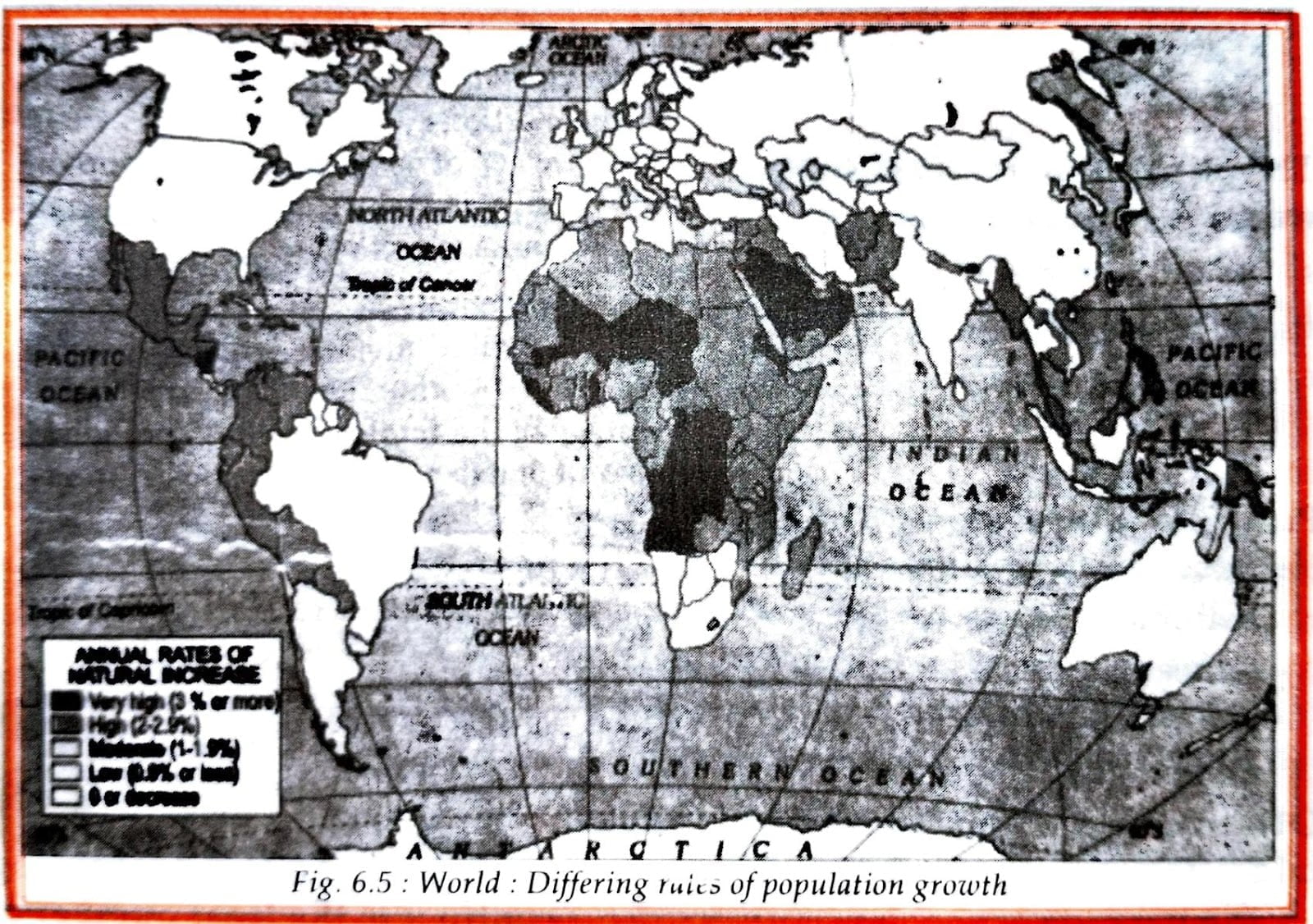
2. On the map of India mark and locate the following regions:
(i) Population density above 1001
(ii) Population density above 401 to 1000
(iii) Population density above 101 to 400
(iv) Population density above 0 to 100
Ans.
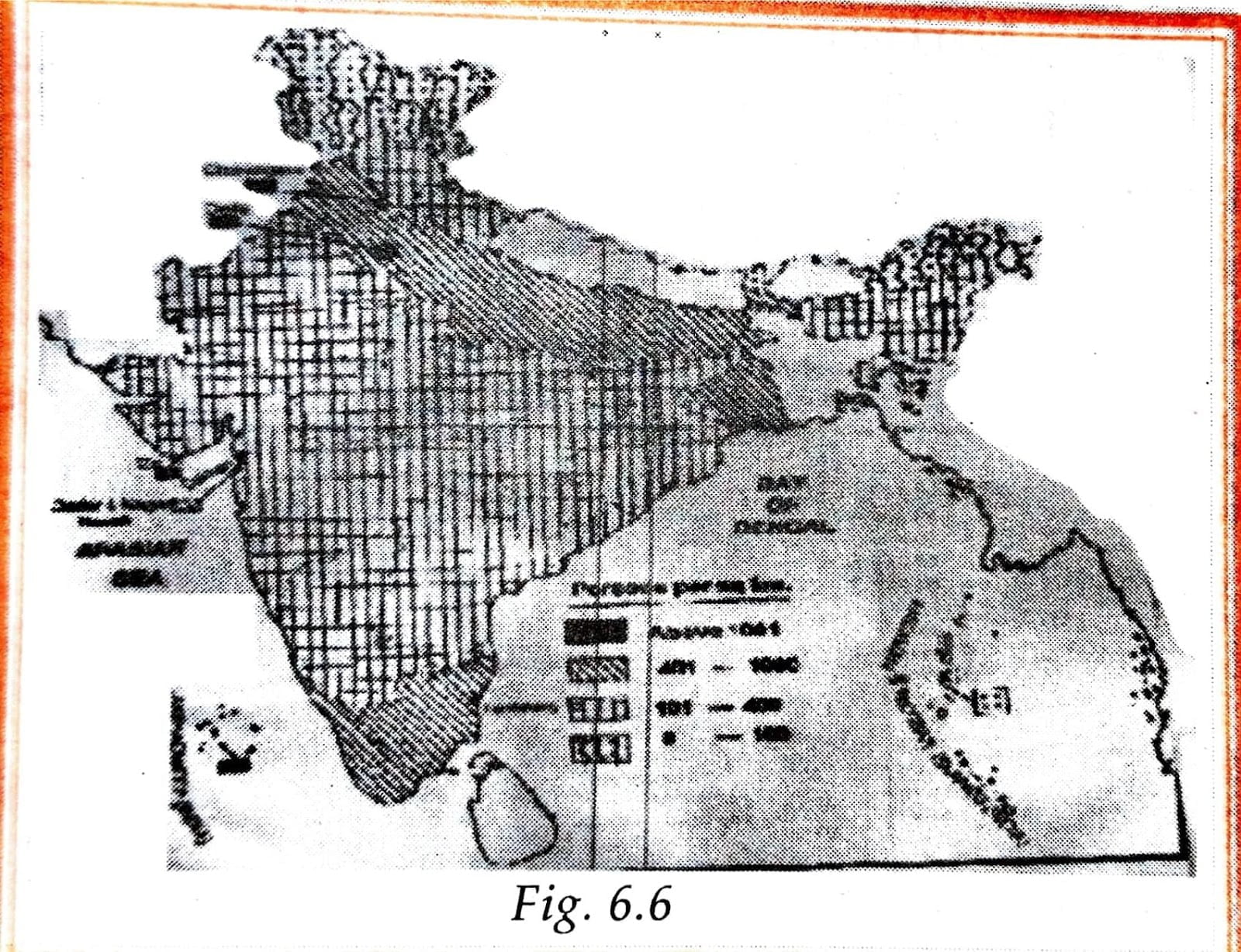
OBJECTIVE TYPE QUESTIONS
I. Multiple Choice Questions
1. The population increase in the world is mainly due to ___________.
(a) Rapid increase in birth rate.
(b) Rapid increase in death rate.
(c) Rapid increase in natural growth rate.
(d) Either of these.
Ans. (c) Rapid increase in natural growth rate.
2. Pune is densely populated because it has facilities:
(a) Better housing.
(b) Education.
(c) Health facilities.
(d) All of these.
Ans. (c) Health facilities.
3. Other word used for out migration is:
(a) In-migration.
(b) Immigration.
(c) Emigration.
(d) None of them.
Ans. (c) Emigration.
4. In countries like United Kingdom, population growth is slowing because of:
(a) Low death rates.
(b) Low birth rates.
(c) Both ‘a’ and ‘b’.
(d) Neither ‘a’ nor ‘b’.
Ans. (b) Low birth rates.
5. Almost three-quarters of the world’s people live in two continents ____________ and __________.
(a) Europe and South America.
(b) Asia and Africa.
(c) North America and Europe.
(d) Europe and Antarctica.
Ans. (c) North America and Europe.
6. Chang Jiang in China and the Nile basin in Egypt are ____________ populated.
(a) Sparsely.
(b) Moderately.
(c) Densely.
(d) None of these.
Ans. (a) Sparsely.
7. Which of the following is the most populated continent?
(a) Asia.
(b) South America.
(c) Africa.
(d) Europe.
Ans. (a) Asia.
8. In Which of the following continents the least number of the people live?
(a) Antarctica.
(b) Europe.
(c) Oceania.
(d) North America.
Ans. (a) Antarctica.
II. Fill in the blanks.
1. The _____________ areas provide better living conditions than the villagers.
Ans. Urban.
2. If the death rate as well as the birth rate are high, then the population pyramid is ____________ at the base.
Ans. Broad.
3. Population can never be ____________ at any place.
Ans. Stable.
4. The general trend of international ___________ is from developing countries to the developed countries.
Ans. Migration.
5. ______________ of population distribution refers to the way in which human beings are spread across the world.
Ans. Pattern.
PICTURE BASED QUESTIONS
1. Look at the population pyramid shown in the given picture. Answer the questions that follows:
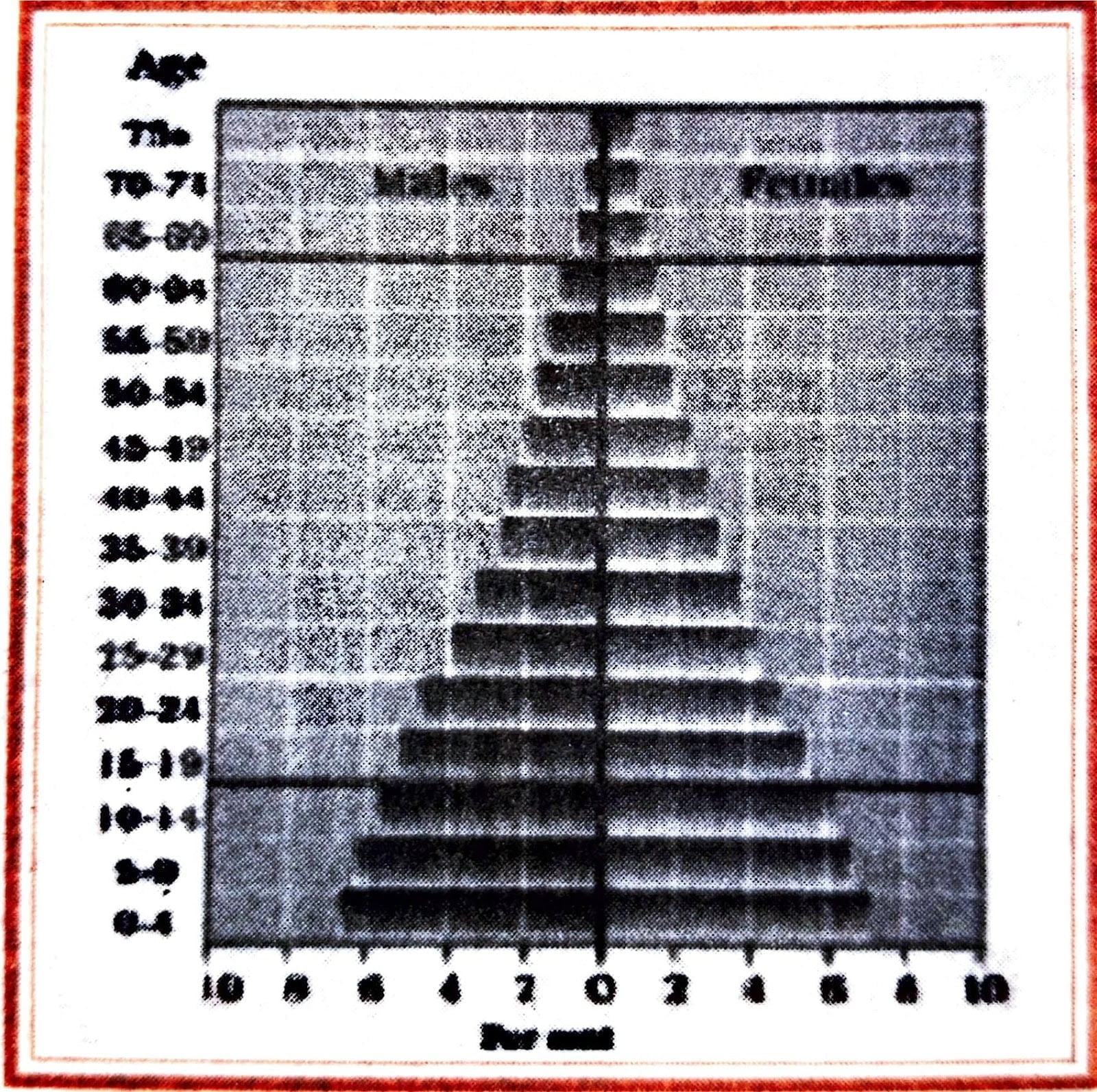
(i) To which country does it belong to?
Ans. It belongs to Kenya.
(ii) Why is it broad at the base?
Ans. This is broad at the base because many children are born.
(iii) Why does the population pyramid rapidly narrows towards the top?
Ans. The population pyramid rapidly narrows towards the top because through many children are born, a large percentage of them die in their infancy, relatively few become adults and there are very few old people.

Hi! my Name is Parimal Roy. I have completed my Bachelor’s degree in Philosophy (B.A.) from Silapathar General College. Currently, I am working as an HR Manager at Dev Library. It is a website that provides study materials for students from Class 3 to 12, including SCERT and NCERT notes. It also offers resources for BA, B.Com, B.Sc, and Computer Science, along with postgraduate notes. Besides study materials, the website has novels, eBooks, health and finance articles, biographies, quotes, and more.


